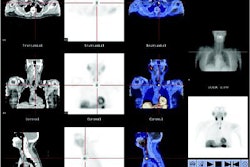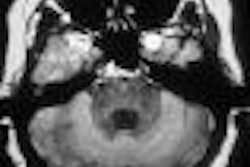Metabolic syndrome patients who also have ischemia on a stress SPECT exam are dealing with more than an added risk to their health. In fact, the likelihood of short-term death or heart attack for such patients is multiplied.
That's the finding of a large-scale multicenter analysis that examined outcomes of patients with metabolic syndrome who underwent stress SPECT technetium-99m tetrofosmin imaging.
The results from nearly 8,000 patients in a multicenter registry study were presented at the 2005 American College of Cardiology (ACC) meeting in Orlando.
Metabolic syndrome, a common precursor to adult-onset diabetes, is diagnosed when patients have at least three of the following conditions:
- Central obesity (a waistline of 40 inches or more for men, 35 inches or more for women)
- Blood pressure measuring 130/85 mm Hg or higher
- Triglyceride level above 150 mg/dL
- Fasting blood glucose level greater than 100 mg/dL
- High-density lipoprotein (HDL) level of less than 40 mg/dL for men or less than 50 mg/dL for women
As expected, the study found that the more metabolic syndrome factors patients have, the more likely they are to have ischemia.
"Roughly speaking, two-thirds of the people who had all five risk factors had at least some amount of ischemia," said lead author Leslee Shaw, Ph.D., an associate professor at the University of California, Los Angeles.
More surprising was the very adverse impact that the combined syndrome and ischemia had on registry participants.
"A lot of (the ischemia) was quite severe," Shaw noted. "It's such that people die at very, very high rates, and we're talking about watching these people for two years, so this is a very short-term survival."
Specifically, patients with five metabolic syndrome factors and a mild-to-severe summed stress score (SSS) on SPECT had an eight- to 15-fold higher risk of death or infarction over two years, Shaw said.
"What we're seeing in the setting of people with diabetes and/or the metabolic syndrome is that even a mild amount of ischemia puts those patients at risk," Shaw said. "We may have to be more aggressive in lowering our thresholds, because even a small amount of ischemia in those patients is associated with a substantially higher risk than for patients without the metabolic syndrome."
The first step in addressing the problem may be to recommend greater use of SPECT or other cardiac imaging to identify those metabolic syndrome patients who also have ischemia, Shaw suggested.
"In those patients that do qualify for a nuclear scan," Shaw said, "maybe nuclear should be part of their risk evaluation so that we can start to initiate risk factor modification -- very aggressive risk factor modification, anti-ischemic therapies -- in order to reduce that ischemic burden."
"The new AHA (American Heart Association) consensus statement on imaging and women has now added diabetes as a key and critical risk component, so you can go directly to imaging," Shaw noted. "I would love to add on, as well, the metabolic syndrome."
By Tracie L. Thompson
AuntMinnie.com staff writer
April 22, 2005
Related Reading
ECG and peripheral arterial disease identify SPECT candidates, January 11, 2005
Stress-induced myocardial ischemia linked to subclinical atherosclerosis, August 18, 2004
Yield of stress SPECT high in asymptomatic diabetics, May 28, 2004
Myocardial ischemia, viability made apparent with MR, February 6, 2004
Referring physicians reserve perfusion imaging for sickest patients, September 30, 2002
Copyright © 2005 AuntMinnie.com



















